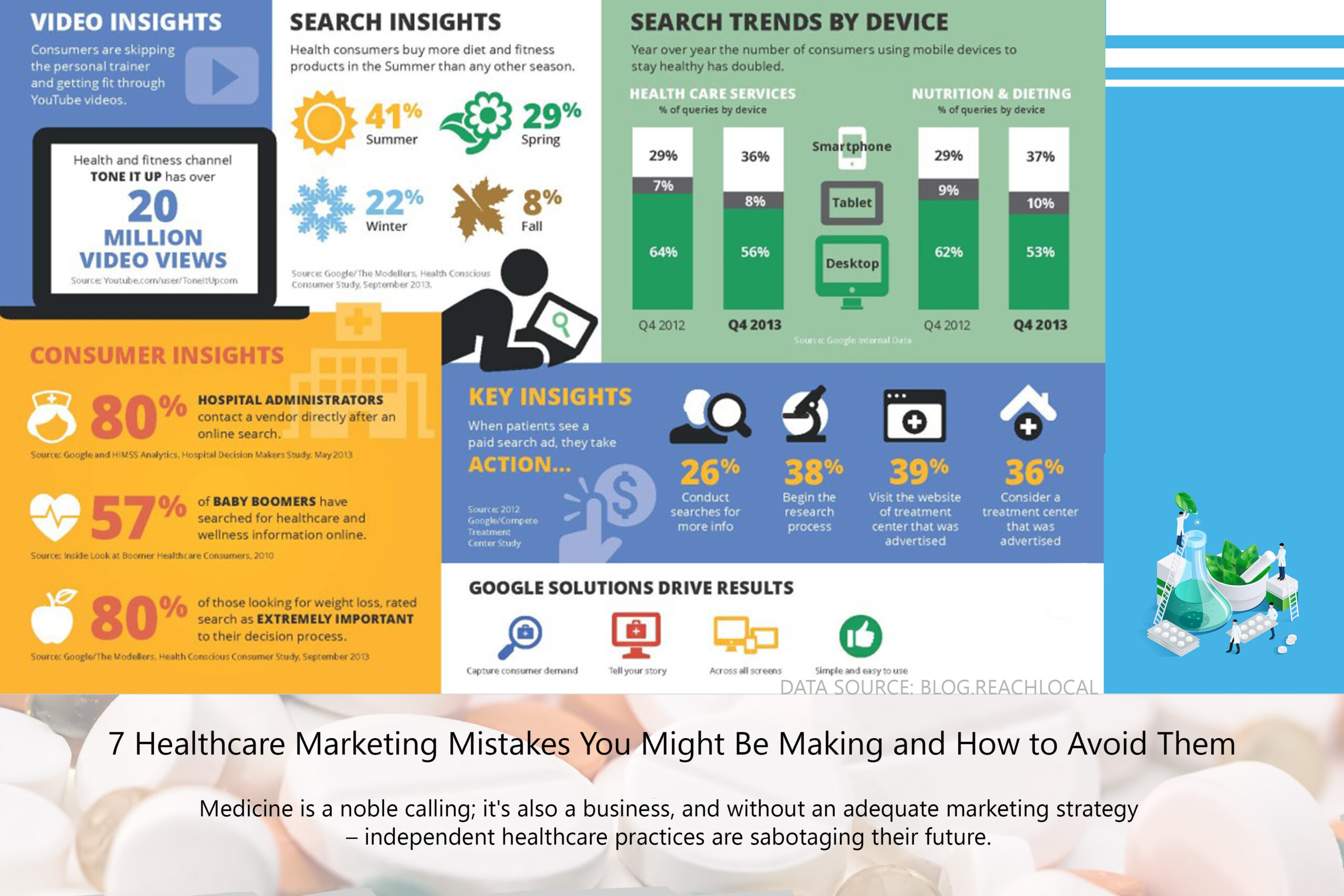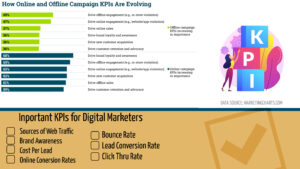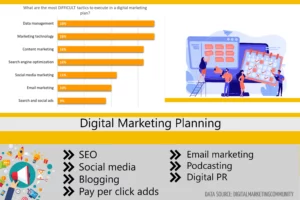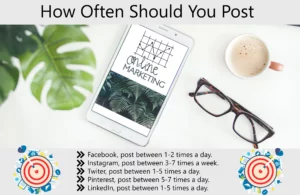
Medicine is a noble calling; it’s also a business, and without an adequate marketing strategy – independent healthcare practices are sabotaging their future.
With research data indicating that about 44% of Generation X and 43% of Millennials are planning to change healthcare providers in the next few years, most independent practitioners are rushing to harness the potential of digital marketing.
Healthcare practitioners have embraced social media, websites, and email marketing to stay competitive in the new field.
Yet, keeping pace with new trends is not easy, and healthcare marketing mistakes are common. Most doctors are not benefiting from the fact that compared to non-search visitors, online searches drive 3 times as many patients.
In this article, we’ll look at the most common healthcare marketing mistakes and provide some tips on avoiding them.
How is Healthcare Marketing Different?
Most standard marketing principles apply to healthcare practitioners as well, with one huge difference – the special advertisement regulation for medication and healthcare services. In most cases, the legal requirements forbid sensational promise and confusing technical language.
Another crucial point of divergence is the marketing’s tendency to create product demand. Doctors can’t hype illnesses to boost their sales but rather promote expertise in resolving them.
Simply put – the overlapping principle in all fields of marketing is brand awareness, and improving patient trust should be the focal point of any healthcare marketing strategy.
Read on to discover 7 common healthcare marketing mistakes and how to avoid them.
Lack of Comprehensive Strategy for Target Audience
The fisherman’s mentality of throwing a hook and hoping something bites is not a long-term recipe for success. Planning is the cornerstone of any marketing strategy – start by defining the goals and customers.
Pediatrists will be interested in a different demographic than gynecologists. Medicine is diverse; identify the target audience and tailor your campaign to appeal to their needs.
A balanced budget is one of the most significant benefits of a marketing strategy. Select the primary advertisement channels like website, social media, and a targeted newsletter. Invest in their continued development and remember – don’t stall the message.
Your daily interaction with patients makes for a perfect research group. Request feedback on what can be improved; focus on the patient experience and use their preferred channels to attract customers that can benefit from your medical expertise.
Neglected Healthcare Website
Business cards were the older generation’s way of sharing contact details, and some healthcare professionals still treat their websites as stationery calling cards. In the 21st century, users consult Google for information. Not surprisingly, organic search drives 51% of all traffic for business, including healthcare practices.
Hire a developer to properly optimize your website for easier navigation and proper indexing by Google crawlers.
The old marketing era is gone; therefore, optimizing for “near me” searches is vital for any business’ success. Research data shows that about 82% of smartphone users type the “near me” keyword in a query at least once a month.
Smartphones bring up another question – is your site mobile-friendly? It’s not complicated to incorporate a responsive design on the website and offer a user-friendly interface that performs well in Google rankings.
A streamlined website is the first step to avoid healthcare marketing mistakes that will hurt your reputation.
Lethargic Social Media Presence
On average, people spend two and a half hours on social media daily. Are you vying for their attention? A Facebook page is a solid asset, but there is a sea of them. The keyword? Engagement!
It’s not enough to have a static page – you should strive to provide an interactive experience. Provide content that will capture the interest of current and potential patients. Medical advice is always welcome, and if correctly presented – there will be no shortage of likes and shares that will help you reach other potential customers.
Although Facebook is still dominant, don’t ignore other branches in the social media tree. Younger people gravitate towards Instagram; about 64% of users on the platform are millennials. Don’t be discouraged by the graphic aspect of some platforms. Benefit from free online resources like Canva, which offers customizable posts and banners that will help transmit your message efficiently.
It may come as a surprise, but YouTube is the second most popular search engine. It’s a rock-solid option for brand visibility if you’re not camera-shy. Videos generally receive more interactivity than photos; it’s a valid fact for most social media platforms.
Thanks to the camera on your mobile device – it’s easy to produce snippets that cover frequently received questions in your inbox. A prosperous channel can turn into a source of income.
All these may seem like a lot of work, but in reality, you only need one message a day that’s in the appropriate format for each platform – it will become a routine in no time.
Failing to Educate and Connect Through Blogging
Publications in medical journals are great, but patients rarely subscribe. Most doctors complain they don’t have time for blogging, a section that is often missing from their website. It’s a great opportunity nonetheless, and it will help you connect with patients and build trust.
Blogging is not hard, especially if you are the master of the topic you’re writing about. When crafting content, it’s crucial to select topics that will resonate with readers. The pandemic is a case in point; most people flocked to medical websites for prevention and treatment advice.
You don’t have to be an SEO expert. Focus on attention-grabbing headlines and relevant content with the appropriate keyword. Make a quick survey of the competition, look at their content structure and ask yourself – how can I make a better blog on the subject?
The plus side is the education you provide to the public, and prevention is the most critical aspect of medicine.
Regular weekly blog posts with relevant content will improve your ranking on Google and serve as a gateway for new patients.
Not Asking Patient for Testimonials
It has been a long-held belief in marketing circles that word-of-mouth is the most effective form of advertisement. Patients want guarantees, and the positive experience of previous customers encourages them to buy a product or a service.
A systematic review of studies on patient online reviews has shown that 59% of Americans have looked online to learn more about a healthcare provider.
Recruit long-time patients to write testimonials on Google or Yelp – they will be happy to help.
As much as it’s confusing, influencers are a new rising niche sector in marketing. If you have a patient with a large social media presence, ask for their endorsement. Their network will cause a cascading effect that you need to absorb through your social media presents.
Forgetting to Analyze Marketing Metrics
Data is a valuable commodity in marketing, and the analytic tools offered by Google and social media platforms create a small treasure chest of ideas for marketing campaigns.
Typically, most small businesses ignore metrics, and that’s a huge mistake. It’s not a labyrinth but a well-structured section that gives an overview of impressions, demographics, number of views, and bounce rate. Learning the terminology is easy, and interpreting the data can be a routine that saves money on unproductive ads.
The best part is that you will no longer shoot in the dark once you learn what works. Analyze which posts receive the most engagement and develop new content along those lines.

Metrics pinpoint the target audience and provide clues to the content they crave.
Wasting Resources on Outbound Marketing
Print media has been declining for over a decade with reduced readership; hence, running an ad in the local newspaper is typically a waste of money. Outbound marketing methods like fliers, billboard ads and radio spots are not as effective now – digital marketing is the real deal.
It’s true, granny doesn’t surf the web, but she is probably comfortable with her choice of doctor. Spending time and money on traditional advertising methods brings small returns on your investment, and redirecting funds on digital marketing strategies is more productive in the long run.
Final Thoughts
Doctors know that mistakes cost their patients dearly, so they go to great lengths to avoid them. But what about the common healthcare marketing mistakes that keep the patients you want to help away from your practice?
Success comes from brand viability – no matter the profession, so focus on exposure through channels with a large targeted audience and small cost of entry. Most of what we’ve mentioned is probably a daily practice in your private life – what lacks is the willpower to put in the effort to refresh the website, consult the metrics chart, and sit down and plan the next month’s marketing campaign.
Doctors help patients, and marketing helps patients find doctors. So, make the process easy and don’t repeat these seven common healthcare marketing mistakes.





